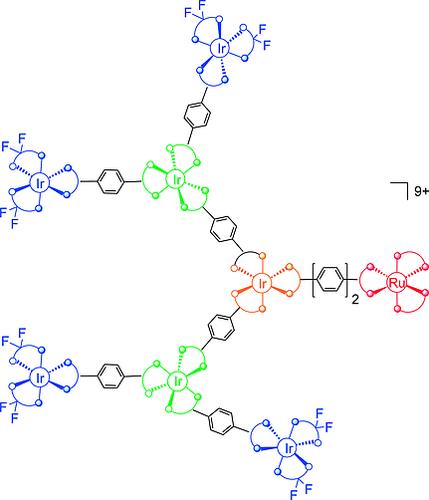当前位置:
X-MOL 学术
›
Eur. J. Inorg. Chem.
›
论文详情
Our official English website, www.x-mol.net, welcomes your feedback! (Note: you will need to create a separate account there.)
Photon Funnels for One-Way Energy Transfer: Multimetallic Assemblies Incorporating Cyclometallated Iridium or Rhodium Units Accessed by Sequential Cross-Coupling and Bromination
European Journal of Inorganic Chemistry ( IF 2.3 ) Pub Date : 2017-10-19 , DOI: 10.1002/ejic.201701020 Kathryn J. Knuckey 1 , J. A. Gareth Williams 1
European Journal of Inorganic Chemistry ( IF 2.3 ) Pub Date : 2017-10-19 , DOI: 10.1002/ejic.201701020 Kathryn J. Knuckey 1 , J. A. Gareth Williams 1
Affiliation

|
The generation of multimetallic assemblies is a widely explored theme, owing to the relevance of controlling energy and electron transfer between metal centres to many fields of contemporary importance. Boronic acid substituted coordination and organometallic complexes have been shown to be useful synthons in the formation of such structures through cross-coupling with halogenated complexes. In this work we used such a methodology to generate an octanuclear mixed-metal compound of composition Ir7Ru having a dendrimer wedge-like structure. The method combined cross-coupling with regiospecific bromination of phenylpyridine (ppy) ligands at the position para to the C–Ir bond. The propensity of Ir(ppy)2-based complexes to electrophilic bromination was found to be deactivated by the introduction of fluorine atoms. The coupling methodology was extended to rhodium-containing systems, exemplified by a tetranuclear system of composition Rh2Ir1Ru1. The synthesis required the use of boronic acid appended RhIII complexes, which could be accessed by the introduction of a neopentyl boronate ester appended bipyridine into the coordination sphere of RhIII. The excited-state energies of the constituent metal units in the resulting multinuclear complexes are such that unidirectional energy transfer occurs from the RhIII/IrIII branches to the RuII core. The luminescence thus resembles that of an isolated [Ru(bpy)3]2+ unit, but the ability of the structure to collect light is greatly enhanced.
中文翻译:

用于单向能量转移的光子漏斗:包含通过顺序交叉耦合和溴化访问的环金属化铱或铑单元的多金属组件
由于控制金属中心之间的能量和电子转移与许多当代重要领域的相关性,多金属组件的生成是一个广泛探索的主题。硼酸取代的配位和有机金属配合物已被证明是通过与卤化配合物交叉偶联形成此类结构的有用合成子。在这项工作中,我们使用这种方法来生成具有树枝状楔形结构的 Ir7Ru 组成的八核混合金属化合物。该方法将交叉偶联与苯基吡啶 (ppy) 配体在 C-Ir 键对位的区域特异性溴化相结合。发现 Ir(ppy)2 基复合物的亲电溴化倾向因引入氟原子而失活。耦合方法扩展到含铑系统,例如组成为 Rh2Ir1Ru1 的四核系统。合成需要使用硼酸附加的 RhIII 复合物,这可以通过将附加的联吡啶的新戊基硼酸酯引入 RhIII 的配位球中来获得。所得多核复合物中金属单元的激发态能量使得能量从 RhIII/IrIII 分支到 RuII 核发生单向转移。因此,这种发光类似于孤立的 [Ru(bpy)3]2+ 单元,但该结构收集光的能力大大增强。这可以通过将新戊基硼酸酯添加到 RhIII 的配位球中来获得。所得多核复合物中金属单元的激发态能量使得能量从 RhIII/IrIII 分支到 RuII 核发生单向转移。因此,这种发光类似于孤立的 [Ru(bpy)3]2+ 单元,但该结构收集光的能力大大增强。这可以通过将新戊基硼酸酯添加到 RhIII 的配位球中来获得。所得多核复合物中金属单元的激发态能量使得能量从 RhIII/IrIII 分支到 RuII 核发生单向转移。因此,这种发光类似于孤立的 [Ru(bpy)3]2+ 单元,但该结构收集光的能力大大增强。
更新日期:2017-10-19
中文翻译:

用于单向能量转移的光子漏斗:包含通过顺序交叉耦合和溴化访问的环金属化铱或铑单元的多金属组件
由于控制金属中心之间的能量和电子转移与许多当代重要领域的相关性,多金属组件的生成是一个广泛探索的主题。硼酸取代的配位和有机金属配合物已被证明是通过与卤化配合物交叉偶联形成此类结构的有用合成子。在这项工作中,我们使用这种方法来生成具有树枝状楔形结构的 Ir7Ru 组成的八核混合金属化合物。该方法将交叉偶联与苯基吡啶 (ppy) 配体在 C-Ir 键对位的区域特异性溴化相结合。发现 Ir(ppy)2 基复合物的亲电溴化倾向因引入氟原子而失活。耦合方法扩展到含铑系统,例如组成为 Rh2Ir1Ru1 的四核系统。合成需要使用硼酸附加的 RhIII 复合物,这可以通过将附加的联吡啶的新戊基硼酸酯引入 RhIII 的配位球中来获得。所得多核复合物中金属单元的激发态能量使得能量从 RhIII/IrIII 分支到 RuII 核发生单向转移。因此,这种发光类似于孤立的 [Ru(bpy)3]2+ 单元,但该结构收集光的能力大大增强。这可以通过将新戊基硼酸酯添加到 RhIII 的配位球中来获得。所得多核复合物中金属单元的激发态能量使得能量从 RhIII/IrIII 分支到 RuII 核发生单向转移。因此,这种发光类似于孤立的 [Ru(bpy)3]2+ 单元,但该结构收集光的能力大大增强。这可以通过将新戊基硼酸酯添加到 RhIII 的配位球中来获得。所得多核复合物中金属单元的激发态能量使得能量从 RhIII/IrIII 分支到 RuII 核发生单向转移。因此,这种发光类似于孤立的 [Ru(bpy)3]2+ 单元,但该结构收集光的能力大大增强。


























 京公网安备 11010802027423号
京公网安备 11010802027423号